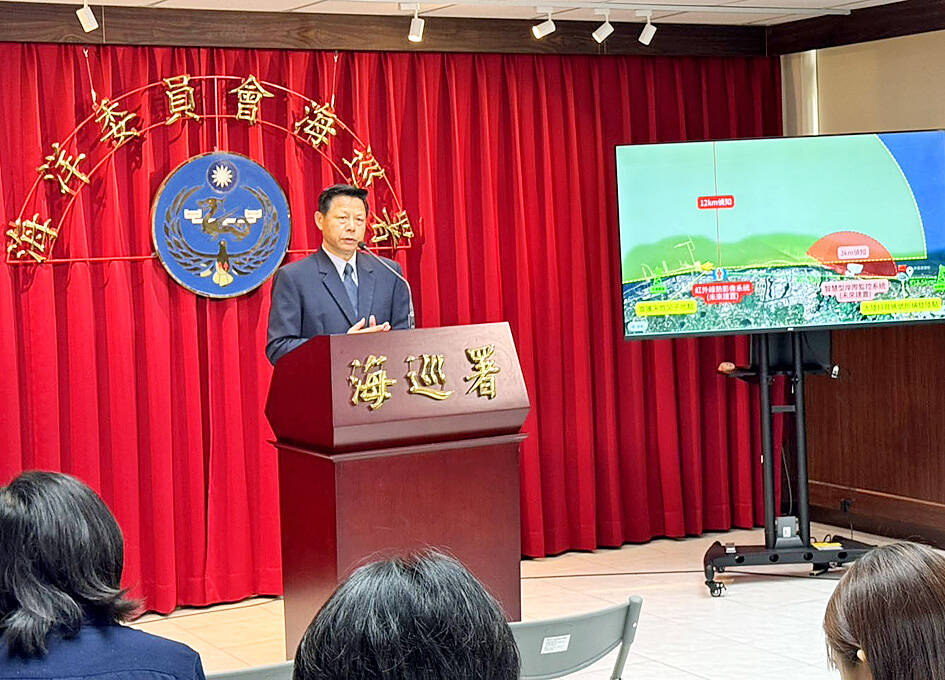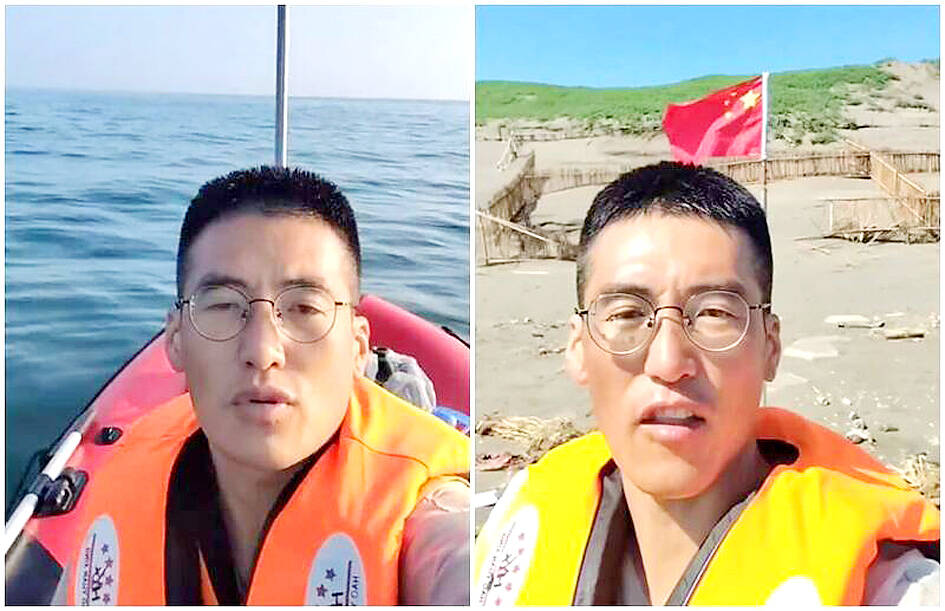China could try to disrupt public morale ahead of President William Lai’s (賴清德) one-year anniversary this week, the Coast Guard Administration (CGA) said yesterday, after images circulated on social media of a person planting a Chinese flag on a Taiwanese beach.
On Sunday, two videos posted on Chinese social media showed a man speaking with a Chinese accent claiming to have sailed across the Taiwan Strait on a small boat landing on a remote beach and planting a Chinese flag.
The man said that he sailed solo from a beach near Fuzhou Changle International Airport in China’s Fujian Province on Thursday, landed in Taiwan the same day, and then returned to China.

Photo: CNA
A GPS screenshot shown at the end of one video indicated a location along the coast of Taoyuan’s Dayuan District (大園), an area dotted with onshore wind turbines.
CGA Deputy Director-General Hsieh Ching-chin (謝慶欽) yesterday told a news conference that although a preliminary analysis had ruled out video forgery, the man did not appear dehydrated or sunburned — conditions typically expected after such a journey.
The CGA has requested assistance from the National Immigration Agency and the Ministry of National Defense, and is reviewing surveillance footage to verify whether the man actually entered Taiwan and whether he received any help inland.

Photo: screenshots from X
The videos, each less than 40 seconds long, had earlier appeared on Douyin (抖音), the Chinese version of TikTok, but were later removed.
The CGA said their removal does not affect its investigation.
On Friday, two Chinese nationals — a father and son — used a rubber dinghy to illegally enter a beach in Taoyuan’s Guanyin District (觀音), 10.9km from the site purportedly shown in the videos posted on Sunday. They were arrested shortly afterward.
Hsieh said that while both incidents were possible, the Guanyin case appeared more credible based on the claimed departure points and fuel amounts involved.
He also acknowledged that the small size of inflatable boats poses a challenge to radar detection and that limited staffing further complicates surveillance efforts.
The number of infrared thermal imaging cameras installed along Taiwan’s coast remains insufficient amid intensifying Chinese incursions, he added.
The CGA has sought additional funding to install more cameras and other surveillance equipment.
Citing China’s “Joint Sword-2024A” military exercise following Lai’s inauguration on May 20 last year, Hsieh said the recent illegal entry cases could be part of Beijing’s strategy to sow confusion in Taiwan around the anniversary of Lai’s first year in office.
So far this year, the CGA has documented five illegal entry cases involving 38 people. All but two were apprehended on site.
Hsieh emphasized the need for harsher penalties for illegal entry.
Under the Immigration Act (入出國及移民法) and the Act Governing Relations Between the People of the Taiwan Area and the Mainland Area (台灣地區與大陸地區人民 關係條例), those who enter Taiwan without authorization can be sentenced to up to five years in prison or fined up to NT$500,000.
However, offenders in so-called “quasi-smuggling” cases have typically received jail terms of no more than eight months or were only fined, Hsieh said.
In other developments, the CGA yesterday deployed patrol ships to repel more than 30 Chinese “three noes” fishing boats — no name, no registration, no flag — that entered the marine territory off Penghu County’s Cimei Island (七美島).
Penghu fishery crews yesterday morning reported sighting more than 30 trawlers suspected of coming from Chinese ports, about 36 nautical miles (66.7km) southwest of Cimei, heading in a northwest direction.
As the Chinese government is enforcing its offseason fishing ban off its coastal waters, it is unusual for such large numbers of fishing vessels to appear in the area, Penghu fishers said.
Additional reporting by Reuters and Liu Yu-ching

A magnitude 7.0 earthquake struck off Yilan at 11:05pm yesterday, the Central Weather Administration (CWA) said. The epicenter was located at sea, about 32.3km east of Yilan County Hall, at a depth of 72.8km, CWA data showed There were no immediate reports of damage. The intensity of the quake, which gauges the actual effect of a seismic event, measured 4 in Yilan County area on Taiwan’s seven-tier intensity scale, the data showed. It measured 4 in other parts of eastern, northern and central Taiwan as well as Tainan, and 3 in Kaohsiung and Pingtung County, and 2 in Lienchiang and Penghu counties and 1

FOREIGN INTERFERENCE: Beijing would likely intensify public opinion warfare in next year’s local elections to prevent Lai from getting re-elected, the ‘Yomiuri Shimbun’ said Internal documents from a Chinese artificial intelligence (AI) company indicated that China has been using the technology to intervene in foreign elections, including propaganda targeting Taiwan’s local elections next year and presidential elections in 2028, a Japanese newspaper reported yesterday. The Institute of National Security of Vanderbilt University obtained nearly 400 pages of documents from GoLaxy, a company with ties to the Chinese government, and found evidence that it had apparently deployed sophisticated, AI-driven propaganda campaigns in Hong Kong and Taiwan to shape public opinion, the Yomiuri Shimbun reported. GoLaxy provides insights, situation analysis and public opinion-shaping technology by conducting network surveillance

Taiwan is gearing up to celebrate the New Year at events across the country, headlined by the annual countdown and Taipei 101 fireworks display at midnight. Many of the events are to be livesteamed online. See below for lineups and links: Taipei Taipei’s New Year’s Party 2026 is to begin at 7pm and run until 1am, with the theme “Sailing to the Future.” South Korean girl group KARA is headlining the concert at Taipei City Hall Plaza, with additional performances by Amber An (安心亞), Nick Chou (周湯豪), hip-hop trio Nine One One (玖壹壹), Bii (畢書盡), girl group Genblue (幻藍小熊) and more. The festivities are to

Auckland rang in 2026 with a downtown fireworks display launched from New Zealand’s tallest structure, Sky Tower, making it the first major city to greet the new year at a celebration dampened by rain, while crowds in Taipei braved the elements to watch Taipei 101’s display. South Pacific countries are the first to bid farewell to 2025. Clocks struck midnight in Auckland, with a population of 1.7 million, 18 hours before the famous ball was to drop in New York’s Times Square. The five-minute display involved 3,500 fireworks launched from the 240m Sky Tower. Smaller community events were canceled across New Zealand’s